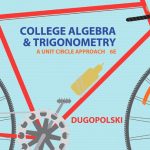College Algebra and Trigonometry
$233.32
| Title | Range | Discount |
|---|---|---|
| Trade Discount | 5 + | 25% |
- Description
- Additional information
Description
This edition features the same content as the traditional text in a convenient, three-hole-punched, loose-leaf version. Books a la Carte also offer a great value–this format costs significantly less than a new textbook. Before you purchase, check with your instructor or review your course syllabus to ensure that you select the correct ISBN. Several versions of Pearson’s MyLab & Mastering products exist for each title, including customized versions for individual schools, and registrations are not transferable. In addition, you may need a CourseID, provided by your instructor, to register for and use Pearson’s MyLab & Mastering products.
With an emphasis on problem solving and critical thinking, Dugopolski’s College Algebra and Trigonometry: A Unit Circle Approach, Sixth Edition gives students the essential strategies to help them develop the comprehension and confidence they need to be successful in this course. Students will find carefully placed learning aids and review tools to help them do the math.
IMPROVE RESULTS WITH MyMathLab®: MyMathLab delivers proven results in helping students succeed and provides engaging experiences that personalize learning.
- NEW! Video Notebook: This printed guide gives students a structured place to take notes as they watch the videos. Definitions, examples, and important concepts are highlighted, and helpful hints are pointed out along the way. The notebook is available in MyMathLab.
- NEW! Video assessment is tied to the video lecture for each section of the book to check student’s conceptual understanding of important math concepts. Instructors can assign these questions as a prerequisite to homework assignments.
- NEW! Getting Ready: Skill review quizzes are assignable throughout the course, testing students on prerequisite knowledge. From these quizzes, each student receives a personalized homework assignment to refresh forgotten concepts.
- NEW! Adaptive Study Plan: Pearson now offers adaptive learning functionality that continuously analyzes student work and points them toward resources that will maximize their potential for understanding and success.
- Skills for Success Module: This module helps students with the transition into college through the transition into professional life.
- Review Your Knowledge: Review Exercises in the text are now assignable in MyMathLab and require students to recall previously learned content and skills. By helping students maintain essential skills throughout the course, they retain information that prepares them for future math courses.
- NEW! Enhanced Graphing Functionality: New functionality within the graphing utility allows graphing of 3-point quadratic functions, 4-point cubic graphs, and transformations in exercises.
STRATEGIES FOR SUCCESS: Learning aids are strategically placed throughout the text giving students guidance right when they needit.
- Chapter Openers discuss real-world situations that use mathematics from that chapter. Examples and exercises then relate back to the opening scenarios.
- Try This exercises after every example give students the opportunity to immediately try a problem that is just like the example and to check their work. Solutions to all Try This exercises are in Online Appendix B.
- Summaries of important concepts are included to help students clarify ideas that have multiple parts.
- Strategies contain general guidelines for accomplishing tasks and are useful for sharpening students’ problem-solving skills.
- Procedures are similar to Strategies, but are more specific and more algorithmic, designed to give students a step-by-step approach for problems.
- Function Galleries show families of functions and their graphs, helping students link the visual aspects with the mathematical properties. These appear throughout the text as appropriate and are also gathered together at the end of the text for easy reference.
- Graphing calculator discussions throughout the text support and enhance algebraic conclusions but are not used to arrive at those conclusions. These are optional and may be skipped, although students who do not use a graphing calculator may still benefit from the graphs and technology discussions.
MILESTONES ALONG THE WAY: Section exercises and review material include the following exercise types so students can practice and check their progress.
- Exercises are arranged by difficulty, from easy to challenging. Exercises that require a graphing calculator are marked with an icon and may be skipped.
- NEW! Data used in examples, exercises, and chapter openers has been updated to make this text relevant for today’s students.
- NEW! The number of fill-in-the-blank exercises has been increased to help students master the concepts.
- NEW! The exercise sets now contain new headings that group the exercises by type: Concepts, Skills, and Modeling.
- NEW! Exercise sets now contain QR codes which link the exercises to solution videos on the Web.
- NEW! Many new Outside the Box exercises have been added so that there are now two of them at the end of every section.
- For Thought exercises are ten true/false questions that review the basic concepts in the section, check student understanding before beginning the exercises, and offer opportunities for writing and discussion. Answers are included in the back of the student edition.
- Hints suggest ways of approaching a problem and give a starting point to solve the application problem. These are given for approximately five application problems in every exercise set.
- Cumulative review exercises at the end-of-section exercises are designed to keep current the skills learned in previous sections and chapters. These exercises are under the heading “Review.”
- Writing/Discussion and Cooperative Learning exercises deepen students’ understanding by giving them the opportunity to express mathematical ideas in writing and to their classmates during small group or team discussions.
- Outside the Box problems are designed to get students (and instructors) to do some mathematics just for fun and encourage students to apply creativity to unique problems. The problems can be used for individual or group work. Answers are given in the Annotated Instructor’s Edition and complete solutions can be found in the Instructor’s Solutions Manual.
- Linking Concepts are multi-part exercises that require the use of concepts from previous sections to illustrate the links among various ideas. This feature can be found at the end of nearly every exercise set. Answers are given in the Annotated Instructor’s Edition, and full solutions can be found in the Instructor’s Solutions Manual.
TYING IT ALL TOGETHER: Chapter review material contains all of the following features to help students review and synthesize the material as they prepare for the road ahead.
- Highlights contain an overview of all of the concepts presented in the chapter along with brief examples to illustrate the concept.
- Chapter Review Exercises give students a comprehensive review of the chapter without reference to individual sections in order to prepare them for the chapter test.
- Chapter Tests measure the students’ readiness for a typical one-hour classroom test. Instructors may also use them as a model for their own end-of-chapter tests.
- Index of Applications list the many applications contained within the text. The applications are page referenced and grouped by subject matter.
P. Prerequisites
P.1 Real Numbers and Their Properties
P.2 Integral Exponents and Scientific Notation
P.3 Rational Exponents and Radicals
P.4 Polynomials
P.5 Factoring Polynomials
P.6 Rational Expressions
P.7 Complex Numbers
1. Equations, Inequalities, and Modeling
1.1 Linear, Rational, and Absolute Value Equations
1.2 Constructing Models to Solve Problems
1.3 Equations and Graphs in Two Variables
1.4 Linear Equations in Two Variables
1.5 Quadratic Equations
1.6 Miscellaneous Equations
1.7 Linear and Absolute Value Inequalities
2. Functions and Graphs
2.1 Functions
2.2 Graphs of Relations and Functions
2.3 Families of Functions, Transformations, and Symmetry
2.4 Operations with Functions
2.5 Inverse Functions
2.6 Constructing Functions with Variation
3. Polynomial and Rational Functions
3.1 Quadratic Functions and Inequalities
3.2 Zeros of Polynomial Functions
3.3 The Theory of Equations
3.4 Graphs of Polynomial Functions
3.5 Rational Functions and Inequalities
4. Exponential and Logarithmic Functions
4.1 Exponential Functions and Their Applications
4.2 Logarithmic Functions and Their Applications
4.3 Rules of Logarithms
4.4 More Equations and Applications
5. The Trigonometric Functions
5.1 Angles and Their Measurements
5.2 The Sine and Cosine Functions
5.3 The Graphs of the Sine and Cosine Functions
5.4 The Other Trigonometric Functions and Their Graphs
5.5 The Inverse Trigonometric Functions
5.6 Right Triangle Trigonometry
6. Trigonometric Identities and Conditional Equations
6.1 Basic Identities
6.2 Verifying Identities
6.3 Sum and Difference Identities
6.4 Double-Angle and Half-Angle Identities
6.5 Product and Sum Identities
6.6 Conditional Trigonometric Equations
7. Applications of Trigonometry
7.1 The Law of Sines
7.2 The Law of Cosines
7.3 Vectors
7.4 Trigonometric Form of Complex Numbers
7.5 Powers and Roots of Complex Numbers
7.6 Polar Equations
7.7 Parametric Equations
8. Systems of Equations and Inequalities
8.1 Systems of Linear Equations in Two Variables
8.2 Systems of Linear Equations in Three Variables
8.3 Nonlinear Systems of Equations
8.4 Partial Fractions
8.5 Inequalities and Systems of Inequalities in Two Variables
8.6 The Linear Programming Model
9. Matrices and Determinants
9.1 Solving Linear Systems Using Matrices
9.2 Operations with Matrices
9.3 Multiplication of Matrices
9.4 Inverses of Matrices
9.5 Solution of Linear Systems in Two Variables Using Determinants
9.6 Solution of Linear Systems in Three Variables Using Determinants
10. The Conic Sections
10.1 The Parabola
10.2 The Ellipse and the Circle
10.3 The Hyperbola
11. Sequences, Series, and Probability
11.1 Sequences and Arithmetic Sequences
11.2 Series and Arithmetic Series
11.3 Geometric Sequences and Series
11.4 Counting and Permutations
11.5 Combinations, Labeling, and the Binomial Theorem
11.6 Probability
11.7 Mathematical Induction
Mark Dugopolski was born in Menominee, Michigan. After receiving a BS from Michigan State University, he taught high school in Illinois for four years. He received an MS in mathematics from Northern Illinois University at DeKalb. He then received a PhD in the area of topology and an MS in statistics from the University of Illinois at Champaign—Urbana. Mark taught mathematics at Southeastern Louisiana University in Hammond for twenty-five years and now holds the rank of Professor Emeritus of Mathematics. He has been writing textbooks since 1988. He is married and has two daughters. In his spare time he enjoys tennis, jogging, bicycling, fishing, kayaking, gardening, bridge, and motorcycling.
IMPROVE RESULTS WITH MyMathLab®: MyMathLab delivers proven results in helping students succeed and provides engaging experiences that personalize learning.
- Video Notebook: This printed guide gives students a structured place to take notes as they watch the videos. Definitions, examples, and important concepts are highlighted, and helpful hints are pointed out along the way. The notebook is available in MyMathLab.
- Video assessment is tied to the video lecture for each section of the book to check student’s conceptual understanding of important math concepts. Instructors can assign these questions as a prerequisite to homework assignments.
- Getting Ready: Skill review quizzes are assignable throughout the course, testing students on prerequisite knowledge. From these quizzes, each student receives a personalized homework assignment to refresh forgotten concepts.
- Adaptive Study Plan: Pearson now offers adaptive learning functionality that continuously analyzes student work and points them toward resources that will maximize their potential for understanding and success.
- Enhanced Graphing Functionality: New functionality within the graphing utility allows graphing of 3-point quadratic functions, 4-point cubic graphs, and transformations in exercises.
MILESTONES ALONG THE WAY: Section exercises and review material include the following exercise types so students can practice and check their progress.
- Data used in examples, exercises, and chapter openers has been updated to make this text relevant for today’s students.
- The number of fill-in-the-blank exercises has been increased to help students master the concepts.
- New headings group the exercises by type: Concepts, Skills, and Modeling.
- QR codes link the exercises to solution videos on the web.
- Many new Outside the Box exercises have been added so that there are now two of them at the end of every section.
CONTENT CHANGES:
- Data used in examples, exercises, and chapter openers has been updated to make this text relevant for today’s students.
- The number of fill-in-the-blank exercises has been increased to help students master the concepts.
- Section 3.4 Miscellaneous Equations has been moved to Chapter 1 to give Chapter 3 a better flow and less material.
- Section 1.5 Scatter Diagrams and Curve Fitting has been moved to Online Appendix A so that Chapter 1 still has seven sections.
- The exercise sets now contain new headings that group the exercises by type: Concepts, Skills, and Modeling.
- Exercise sets now contain QR codes, which link the exercises to videos on the web.
- Many new Outside the Box exercises have been added so that there are now two of them at the end of every section.
- Many calculator screen shots have been updated to the TI-84 Plus calculator.
- Suggested homework problems are indicated in the Annotated Instructor’s Edition. Each section contains approximately 20 underlined exercise numbers, chosen by the author, that can be used as an initial assignment of homework exercises.
Additional information
| Dimensions | 1.42 × 8.43 × 10.87 in |
|---|---|
| Imprint | |
| Format | |
| ISBN-13 | |
| ISBN-10 | |
| Author | |
| Subjects | mathematics, higher education, Precalculus, Algebra and Trigonometry |




